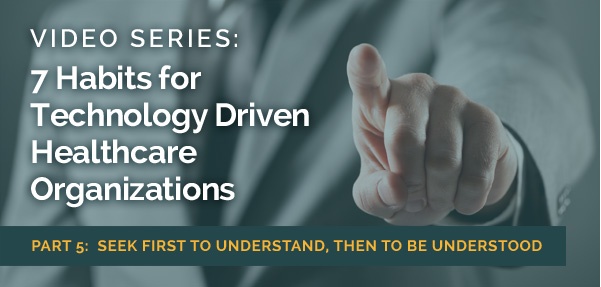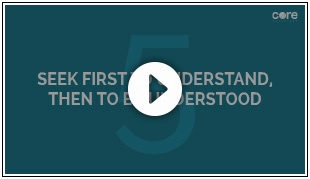6 Key Lessons for a Successful EHR Implementation
by Core Solutions on April 18, 2016

This article is part 5 of a 7-part series derived from ‘7 Habits for Technology Driven Healthcare Organizations’ – a presentation led by Ravi Ganesan, President of Core Solutions, at the 2015 Open Minds Technology & Informatics Institute.
We spend years learning how to read, write and speak – but what about listening? The reality of this question is relevant to many large health and human services organizations that are reliant on teamwork and strong listening skills to make decisions – especially when it comes to EHR implementation. Instead of listening to others however, most people are framing their response by evaluating, probing, advising and interpreting the speaker.
This common example demonstrates how communication breakdowns can lead to unsuccessful EHR implementations: an organization will spend 16 months deciding on the need for a new EHR, followed by another 12 months selecting the right vendor, and lastly asking the vendor to recreate their current system. Sound familiar?
As a result, it’s vital that organizations invest time in conversations with their EHR vendor to absorb information that is critical to a successful EHR implementation, including:
- Leadership Support
An EHR implementation process cannot be successful without leadership commitment. It is inevitable that challenges will arise during the process and to remain on time and on-budget, it’s especially important that dedicated leaders are available to lend support. - Right Implementation Approach
One-size-fits-all does not apply to EHR implementation. Every organization is unique and needs to collaborate with their EHR vendor to craft a solution that works for their organization. This includes pilot-projects and custom plans for taking the system live. - Strong Training
Training your staff to properly utilize the EHR is critical and takes time. It’s important to utilize training best practices offered by your EHR vendor to streamline processes and ensure that everyone realizes the full potential of the system. - Support for Go-Live
Most organizations celebrate when their EHR goes live, but often forget that there is a lot of support needed at this time for executives, managers, frontline clinicians and patients. Additionally, there is a 60-to-90 day adoption curve that requires consistent support. - Flexibility
For a project-plan to maintain its schedule from day one to completion is nearly impossible. People have questions, concerns and other priorities that cause setbacks and as a result, staying flexible during the process with built-in contingency time is key. - Ongoing Optimization
Once the adoption-curve has passed, it’s important to continuously leverage your EHR vendor to optimize your system to stay competitive.
- April 2024 (2)
- March 2024 (4)
- February 2024 (1)
- October 2023 (3)
- September 2023 (3)
- August 2023 (2)
- June 2023 (2)
- May 2023 (3)
- April 2023 (4)
- March 2023 (2)
- November 2022 (3)
- October 2022 (1)
- September 2022 (1)
- August 2022 (3)
- July 2022 (1)
- June 2022 (1)
- January 2022 (2)
- December 2021 (1)
- October 2021 (2)
- September 2021 (2)
- August 2021 (2)
- July 2021 (5)
- June 2021 (5)
- March 2021 (2)
- January 2020 (3)
- November 2019 (3)
- October 2019 (2)
- July 2019 (1)
- June 2019 (1)
- May 2019 (1)
- April 2019 (3)
- October 2018 (1)
- September 2018 (1)
- August 2018 (1)
- July 2018 (1)
- June 2018 (1)
- May 2018 (2)
- April 2018 (1)
- March 2018 (1)
- December 2017 (1)
- October 2017 (2)
- September 2017 (1)
- June 2017 (2)
- May 2017 (2)
- April 2017 (1)
- February 2017 (2)
- January 2017 (3)
- November 2016 (2)
- October 2016 (3)
- September 2016 (2)
- August 2016 (1)
- July 2016 (2)
- June 2016 (1)
- May 2016 (3)
- April 2016 (2)
- March 2016 (2)
- February 2016 (2)
- January 2016 (3)
- December 2015 (2)
- November 2015 (4)
- October 2015 (3)
- September 2015 (4)
- August 2015 (1)



Let us know what you think